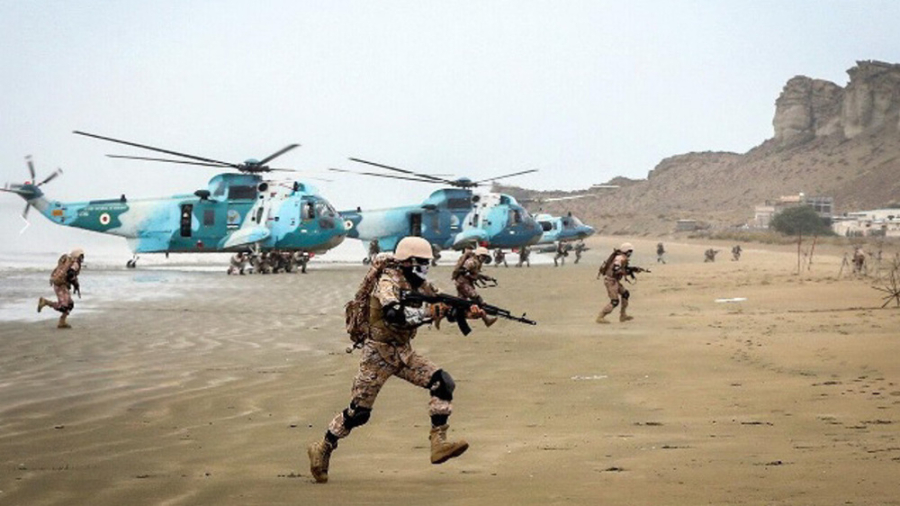Iran’s top military command has underlined the total combat readiness of the country’s Armed Forces in fighting off any potential acts of aggression by enemies against Iranian soil.
“The Armed Forces are in full readiness, closely monitoring any enemy movements, and if they make any miscalculation and attempt to encroach on the sacred soil of our country again, they will face a more crushing response,” the commander of the Khatam al-Anbiya Central Military Headquarters said on Wednesday.
The announcement comes as the Iranian Navy is scheduled to kick off the operational phase of its Eqtedar (Authority) 1404 missile exercise on Thursday.
Navy spokesperson Rear Admiral Abbas Hassani said the two-day missile exercise will take place in the Sea of Oman and the northern Indian Ocean, involving surface and subsurface vessels, aerial units, coast-to-sea missile sites, sea-based missile platforms, and electronic warfare units.
Hassani added that the exercise will also incorporate missile launches, electronic warfare drills, and drone operations based on experience gained during previous exercises and established operational guidelines.
Pointing to the armaments and missile systems, the Navy spokesperson underlined that a wide range of precision cruise missiles with short, medium, and long ranges will be leveraged to target and destroy surface vessels.
Hassani also emphasized that the exercise aims to enhance the force's combat readiness, boost public confidence, improve operational planning, command and control capabilities, and strengthen deterrence based on domestic expertise.
Iran to use new missiles in case of new aggression: Minster
Also on Wednesday, Iran's Defense Minister Brigadier General Aziz Nasirzadeh said the missiles the Armed Forces used against Israel in June’s 12-day war had been domestically produced a few years ago, warning that newly-manufactured missiles with much better capabilities would be used in case of any fresh Israeli onslaught.
“In the 12-day war, we faced a fully supported power. In this war, the Islamic Republic of Iran did not confront only the Zionist regime, as the entire logistical, intelligence, and support capabilities of the United States were present in this war,” Nasirzadeh said.
Stressing that the Iranian Armed Forces had no reliance on foreign resources and used what was made by the country's defense industries, Nasirzadeh said the world witnessed that the missiles launched by Iran hit their targets perfectly and inflicted severe damage on the Israeli regime.
“The missiles used in the 12-day war were manufactured by the Defense Ministry a few years ago. Today, we have manufactured and possess missiles that have much better capabilities than previous missiles, and if the Zionist enemy undertakes another act of adventurism (against Iran), we will definitely use these missiles,” he added.
Nasirzadeh also said the Israeli regime had used the full power of its so-called air defense systems during the 12-day war, including the THAAD, MIM-104 Patriot, Iron Dome, and Arrow systems.
“Despite the use of all these systems, the Zionist regime only prevented about 40 percent of our missiles from hitting in the first days of the war. But in the final days of the war, 90 percent of our missiles were hitting their targets, which made it clear that our experience had increased while the opposing side’s defense capabilities had decreased,” he added.
“If this trend had continued, the Islamic Republic’s Armed Forces would have definitely had the upper hand.”
On June 13, 2025, the Israeli regime launched strikes against Iran, targeting several civilian, military, and nuclear facilities, which led to the assassination of a number of Iranian military commanders and nuclear scientists.
In retaliation, Iran unleashed waves of drones and missiles at the occupied territories under the operational name True Promise III, inflicting significant damage on both settlements and military installations.
On June 22, 2025, the US Air Force and Navy carried out airstrikes against three Iranian nuclear facilities in an attempt to relieve pressure on the Israeli regime.
The following day, June 23, Iranian forces retaliated with over 30 drones and missiles against the US base in Qatar, under the codename Operation Glad Tidings of Victory, damaging multiple parts of the facility.
Finally, on June 24, after suffering heavy losses at the hands of Iran’s Armed Forces, both the Israeli regime and the US were forced to agree to a cessation of hostilities.
Press TV’s website


















